Seminole Gulf Railway
The Seminole Gulf Railway (reporting mark SGLR) is a short line freight and passenger excursion railroad headquartered in Fort Myers, Florida, that operates two former CSX Transportation railroad lines in Southwest Florida. The company's Fort Myers Line, which was previously the southernmost segment of CSX's former Fort Myers Subdivision, runs from Arcadia south to North Naples via Punta Gorda, Fort Myers, Estero, and Bonita Springs. They also operate another former CSX line that runs from Oneco south through Sarasota. Seminole Gulf acquired the lines in November 1987 and operates its own equipment.[1]
 | |
 EMD GP9 of the Seminole Gulf Railway | |
| Overview | |
|---|---|
| Headquarters | Fort Myers, Florida |
| Reporting mark | SGLR |
| Locale | Southwest Florida |
| Dates of operation | 1987–present |
| Predecessor |
|
| Technical | |
| Track gauge | 4 ft 8 1⁄2 in (1,435 mm) standard gauge |
| Other | |
| Website | semgulf |
The Seminole Gulf Railway has a commonly owned affiliated company, the Bay Colony Railroad Corp. (reporting mark BCLR), which is based in southeastern Massachusetts.
Current operations
Seminole Gulf Railway is one of two freight railroad operating in Southwest Florida (the other is South Central Florida Express, who operates tracks farther inland near Clewiston). Freight transported by Seminole Gulf Railway includes lumber, propane, stone, steel, scrap metal, and other commodities.[2] Freight is interchanged with CSX usually once or twice a week on each line. On the Fort Myers Line, freight trains between the yard in Fort Myers and Arcadia are known as the Desoto Turn.[3] The Desoto Turn switches customers between North Fort Myers and Arcadia while industries in Fort Myers and south of there are switched locally from the yard.
Murder Mystery Dinner Train & Excursions
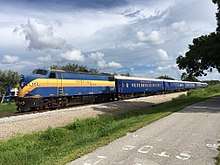
In addition to carrying freight, Seminole Gulf Railway also operates a popular Murder Mystery Dinner Train from Fort Myers. The dinner train runs five nights a week, year-round from a station at Colonial Boulevard north to a point just south of Punta Gorda before returning. The dinner train utilizes a fleet of 1930s-era vintage rail cars named after nearby barrier islands (some of which were previously Ringling Bros. and Barnum & Bailey Circus rail cars). The dinner train includes a five-course dinner and has featured over 80 different murder mystery productions throughout its history.[4]
Special holiday dinner trains also operate including Sweetheart Express on Valentine's Day, Halloween Ghost Train, New Year's Eve Gala, and Christmas Rail-Boat (which runs to the historic Punta Gorda Atlantic Coast Line Depot for a Christmas boat tour through Punta Gorda Isles) to name a few.[5][6]
Seminole Gulf has also operated general excursion trains in the past. Seminole Gulf introduced passenger excursion trains in 1991 after losing a major freight customer. Excursion trains and were initially based from a small platform in North Naples near Railhead Park, but moved to the current station at Colonial Boulevard in Fort Myers shortly after.[7]
The dinner and excursion trains are often pulled by one of two vintage EMD F-unit locomotives, SGLR 501 and SGLR 502. SGLR 501, an F9AM, was previously operated by the Milwaukee Road, while SGLR 502, an F7, was previously operated on the Baltimore and Ohio Railroad. Both were later acquired by the Long Island Rail Road, where they were converted into cab cars and used from the 1970s until 1999, before being sent to the SGLR.
Fort Myers Line
Seminole Gulf Railway | |||||||||||||||||||||||||||||||||||||||||||||||||||||||||||||||||||||||||||||||||||||||||||||||||||||||||||||||||||||||||||||||||||||||||||||||||||||||||||||||||||||||||||||||||||||||||||||||||||||||||||||||||||||||||||||||||||||||||||||||||||||||||||||||||||||||||||||||||||||||||
|---|---|---|---|---|---|---|---|---|---|---|---|---|---|---|---|---|---|---|---|---|---|---|---|---|---|---|---|---|---|---|---|---|---|---|---|---|---|---|---|---|---|---|---|---|---|---|---|---|---|---|---|---|---|---|---|---|---|---|---|---|---|---|---|---|---|---|---|---|---|---|---|---|---|---|---|---|---|---|---|---|---|---|---|---|---|---|---|---|---|---|---|---|---|---|---|---|---|---|---|---|---|---|---|---|---|---|---|---|---|---|---|---|---|---|---|---|---|---|---|---|---|---|---|---|---|---|---|---|---|---|---|---|---|---|---|---|---|---|---|---|---|---|---|---|---|---|---|---|---|---|---|---|---|---|---|---|---|---|---|---|---|---|---|---|---|---|---|---|---|---|---|---|---|---|---|---|---|---|---|---|---|---|---|---|---|---|---|---|---|---|---|---|---|---|---|---|---|---|---|---|---|---|---|---|---|---|---|---|---|---|---|---|---|---|---|---|---|---|---|---|---|---|---|---|---|---|---|---|---|---|---|---|---|---|---|---|---|---|---|---|---|---|---|---|---|---|---|---|---|---|---|---|---|---|---|---|---|---|---|---|---|---|---|---|---|---|---|---|---|---|---|---|---|---|---|---|---|---|---|---|---|
Fort Myers Line | |||||||||||||||||||||||||||||||||||||||||||||||||||||||||||||||||||||||||||||||||||||||||||||||||||||||||||||||||||||||||||||||||||||||||||||||||||||||||||||||||||||||||||||||||||||||||||||||||||||||||||||||||||||||||||||||||||||||||||||||||||||||||||||||||||||||||||||||||||||||||
| |||||||||||||||||||||||||||||||||||||||||||||||||||||||||||||||||||||||||||||||||||||||||||||||||||||||||||||||||||||||||||||||||||||||||||||||||||||||||||||||||||||||||||||||||||||||||||||||||||||||||||||||||||||||||||||||||||||||||||||||||||||||||||||||||||||||||||||||||||||||||
| Note: Not to scale | |||||||||||||||||||||||||||||||||||||||||||||||||||||||||||||||||||||||||||||||||||||||||||||||||||||||||||||||||||||||||||||||||||||||||||||||||||||||||||||||||||||||||||||||||||||||||||||||||||||||||||||||||||||||||||||||||||||||||||||||||||||||||||||||||||||||||||||||||||||||||
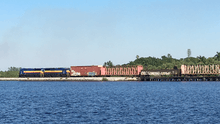
Seminole Gulf's Fort Myers Line, which extends nearly 80 miles, begins in Arcadia and runs south to Punta Gorda, Fort Myers, Bonita Springs, and North Naples.
The Fort Myers Line begins just north of Arcadia, where it continues south from CSX's Brewster Subdivision (at milepost SVC 880.75)[8]. From this point, it briefly runs along the former Charlotte Harbor and Northern/Seaboard Air Line Railroad across the Peace River, passing Morgan Park, and into the Arcadia yard. CSX has trackage rights into Arcadia yard to facilitate the interchange between the two companies.[9]
From the yard, the main line continues from a wye southeast a short distance toward Downtown Arcadia before turning south on to the former Florida Southern/Atlantic Coast Line Railroad. It runs south-southwest from Arcadia roughly paralleling the Peace River through Fort Ogden and Cleveland to Punta Gorda. In Punta Gorda, it turns south and then southeast closely paralleling Interstate 75 towards North Fort Myers before crossing the Caloosahatchee River between there and Tice. The crossing over the Caloosahatchee River includes a drawbridge and series of trestles that traverse Beautiful Island. From Tice on the south side of the river, the line heads southwest towards Downtown Fort Myers. Just east of downtown, the line turns south again through an industrial area. Seminole Gulf's main switching yard in Fort Myers is located underneath the Metro Parkway overpass, and a maintenance yard is just south of Colonial Boulevard next to Page Field.
The line continues south from Fort Myers along the Ten Mile Canal (the John Yarbrough Linear Park parallels the line along the canal). The line has a short spur just north San Carlos Park known as the Baker Spur, which extends west a little over a mile along Alico Road.
From the Baker Spur junction, the main line then heads south through Estero and Downtown Bonita Springs before terminating near Wiggins Pass Road in North Naples, just a mile south of the Lee/Collier County line. Though, his segment of the main line is currently inactive and has not had any active shippers since around 2008.[10]
History
What is now Seminole Gulf Railway's main line came into existence incrementally in the late 1800s and early 20th century.
The northernmost section of the Seminole Gulf track along with the Arcadia yard and the CSX line to the north was originally built by the Charlotte Harbor and Northern Railway. Built from 1907 to 1910, the Charlotte Harbor and Northern Railway (which would later be acquired by the Seaboard Air Line Railroad in 1926) historically extended from Arcadia south to Boca Grande. The line from the Arcadia yard southeast along Pine Street was the Charlotte Harbor and Northern's connecting track to the Florida Southern Railway.
From this point south, Seminole Gulf continues south along the former Florida Southern Railway (a subsidiary of Henry Plant's system of railroads) south to Punta Gorda. This segment was built in 1886 making it the oldest segment of the Seminole Gulf line and was the southernmost segment of the Florida Southern's Charlotte Harbor Division, which originated in Bartow. The original Florida Southern route north of Arcadia (which ran past the historic Arcadia passenger depot) was removed in the mid 1980s. Surveying work to determine the route for the Florida Southern Railway to Punta Gorda was done by Punta Gorda civil engineer Albert W. Gilchrist, who would later serve as Florida's 20th governor. The line's first train to Punta Gorda arrived on July 24, 1886. The line, originally built as narrow gauge, was widened to standard gauge in 1892, and the Florida Southern was fully integrated with the Plant System in 1896.[11]
In Punta Gorda, the line initially continued west through the city and terminated at a dock facility in the Peace River near Charlotte Harbor. This dock, known as the Long Dock, was located near the Punta Gorda Isles Yacht Club (a mile west of where Fishermen's Village stands today).[12] A passenger depot was also located near King Street (the historic depot on Taylor Street was built later in 1928). Punta Gorda became the southernmost point the Plant System ever reached, and the railroad's arrival is largely responsible for Punta Gorda's development as a city, which was incorporated four years later. Today, the spur near Elizabeth Street in Punta Gorda is all that remains of the original alignment to the Punta Gorda docks (the Punta Gorda Linear Park today runs along the rest of that route west of US 41).
Charlotte Harbor was Henry Plant's ultimate goal and he had no interest in having the line continue south to Fort Myers. This is despite the fact that Plant opened a hotel in Fort Myers in 1896.[13] Fort Myers sought railroad service and had already been established as a city when the Florida Southern was complete unlike Punta Gorda. After Plant's death in 1899, his heirs would sell his entire system of railroads to the Atlantic Coast Line Railroad in 1902, and serving Fort Myers quickly became a top priority for Atlantic Coast Line president Henry Walters. The extension of the line to Fort Myers via Tice was completed on May 10, 1904, making it the Coast Line's first expansion of the former Plant System. The alignment through Tice was selected so the line would cross the wide Caloosahatchee River farther upstream at Beautiful Island, where less extensive bridge work was needed.[14] The extension included a depot at Main and Monroe Streets and a wharf along the Caloosahatchee River at the end of Monroe Street in downtown Fort Myers. The original depot would be replaced with the depot that still stands today on Peck Street (now Widman Way) in 1924, and the wharf would only exist until 1944. The spur that runs from the line just south of State Road 82 is all that remains of the wye and tracks that once served the downtown Fort Myers depot and docks. Fort Myers also experienced major growth after the arrival of the railroad and would remain the southernmost point of the entire Atlantic Coast Line Railroad system until the Florida land boom of the 1920s.
Once the land boom was underway, the Coast Line partnered with a number of local businessmen including advertising entrepreneur Barron Collier, who owned large amounts of land in the newly-created Collier County. Through this partnership, they acquired the dormant charter of the unbuilt Fort Myers Southern Railroad, and the line was extended further south towards Collier County. It reached Bonita Springs by late 1925 where a depot was built just south of the Imperial River (the depot has since been demolished but the depot's platform and siding still remain near Riverside Park).[15] The line was further extended to Naples by December 1926, and to Collier City on Marco Island in mid 1927. At the same time, the Seaboard Air Line Railroad (via their Seaboard-All Florida Railway subsidiary) built a competing line from Fort Ogden to Fort Myers and Naples. Seaboard's service to Naples commenced eleven days after the Coast Line. Seaboard discontinued service to Naples in 1942 and the Atlantic Coast Line rerouted their line from Vanderbilt Beach to the Seaboard's former passenger depot on Fifth Avenue South.
The Atlantic Coast Line became the Seaboard Coast Line Railroad in 1967. The Baker Spur just north of San Carlos Park was then built in 1973. The Baker Spur would extend beyond the route of Interstate 75 to serve rock mines in eastern Lee County on land owned by the Atlantic Land and Improvement Company (known today as Alico, Inc.), which at one point had been a subsidiary of the Atlantic Coast Line Railroad and was the holding company for its real estate division. Seminole Gulf abandoned the easternmost three miles of the Baker Spur in 1994.[16]
Intercity passenger service to Southwest Florida was discontinued in 1971 upon the creation of Amtrak, who opted not to serve Southwest Florida. In 1979, tracks into downtown Naples were removed when the line was cut back to its current terminus in North Naples, a year before Seaboard Coast Line would become CSX (nine years before Seminole Gulf would begin operating it).[3]
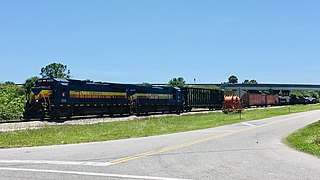 Desoto Turn near Punta Gorda
Desoto Turn near Punta Gorda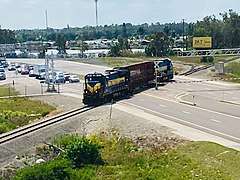 Seminole Gulf freight train crossing Alico Road near the Baker Spur junction south of Fort Myers
Seminole Gulf freight train crossing Alico Road near the Baker Spur junction south of Fort Myers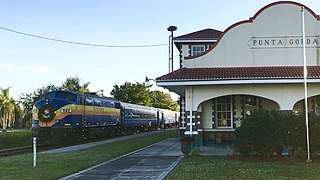 Seminole Gulf's Christmas Rail-Boat at Punta Gorda Depot in 2019
Seminole Gulf's Christmas Rail-Boat at Punta Gorda Depot in 2019 Seminole Gulf track though Downtown Bonita Springs. The platform is all that remains of the Atlantic Coast Line's passenger depot
Seminole Gulf track though Downtown Bonita Springs. The platform is all that remains of the Atlantic Coast Line's passenger depot- Bridge over Peace River near Arcadia
Sarasota Line
Seminole Gulf Railway | ||||||||||||||||||||||||||||||||||||||||||||||||||||||||||||||||||||||||||||||||||||||||||||||||||||||||||||||||||||||||||||||||||||||||||||||||
|---|---|---|---|---|---|---|---|---|---|---|---|---|---|---|---|---|---|---|---|---|---|---|---|---|---|---|---|---|---|---|---|---|---|---|---|---|---|---|---|---|---|---|---|---|---|---|---|---|---|---|---|---|---|---|---|---|---|---|---|---|---|---|---|---|---|---|---|---|---|---|---|---|---|---|---|---|---|---|---|---|---|---|---|---|---|---|---|---|---|---|---|---|---|---|---|---|---|---|---|---|---|---|---|---|---|---|---|---|---|---|---|---|---|---|---|---|---|---|---|---|---|---|---|---|---|---|---|---|---|---|---|---|---|---|---|---|---|---|---|---|---|---|---|---|
Sarasota Line | ||||||||||||||||||||||||||||||||||||||||||||||||||||||||||||||||||||||||||||||||||||||||||||||||||||||||||||||||||||||||||||||||||||||||||||||||
| ||||||||||||||||||||||||||||||||||||||||||||||||||||||||||||||||||||||||||||||||||||||||||||||||||||||||||||||||||||||||||||||||||||||||||||||||
| Note: Line with SW mileposts is the original Seaboard Air Line route. AZA mileposts are along the former Atlantic Coast Line route. | ||||||||||||||||||||||||||||||||||||||||||||||||||||||||||||||||||||||||||||||||||||||||||||||||||||||||||||||||||||||||||||||||||||||||||||||||
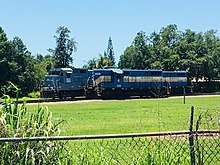
In Sarasota, Seminole Gulf largely operates on a u-shaped line. The northwest end of the line is located just south of Bradenton in Oneco, where it continues south from CSX's Palmetto Subdivision. The interchange point is located a little over a mile south of CSX's Tropicana Yard, where a side track facilitates the interchange between the two companies. From Oneco, the line heads due south along former Seaboard Air Line Railroad tracks towards Sarasota, passing through Tallevast and close to Sarasota-Bradenton International Airport. The line's locomotives are stored on a spur into Suburban Propane on Whitfield Avenue in Tallevast. Just north of Downtown Sarasota, the line turns east onto former Atlantic Coast Line Railroad tracks and comes to a wye just east of US 301. From the wye, the line turns back north along the former Atlantic Coast Line main line and terminates just south of Whitfield Avenue in Motoaka.
The line went as far south as Venice when Seminole Gulf first began operating it. Track to Venice previously ran from the wye at the southeast corner of the current line and went south-southeast through Fruitville, Bee Ridge, Palmer Ranch and Nokomis.[17] Track was abandoned south of Palmer Ranch in 2004 and the remaining line up to Fruitville Road was abandoned in 2019. Sarasota County built the popular Legacy Trail on the former right of way and is in the process of extending it north to Fruitville Road on the remaining right of way.[18][19]
History
The first trackage of the Sarasota line to be built (the west track) was built by the Seaboard Air Line (through their Florida West Shore Railway subsidiary) in 1903. It was part of a line that extended from Durant (just east of Tampa), to Sarasota via Parrish, Palmetto and Bradenton. Some of the line was built on the former road bed of the Arcadia, Gulf Coast and Lakeland Railroad, an earlier unsuccessful railroad between Bradenton and Sarasota.[3] In Sarasota, the tracks originally continued south into downtown along Lemon Avenue and served a dock facility in Sarasota Bay. In 1905, Seaboard extended the line east into Fruitville, which initially ran southeast along Pineapple Avenue and then east along what is now Alderman Street and Brother Geenen Way. In 1911, at the request of local socialite Bertha Honoré Palmer, the line was extended south to Venice.
The Atlantic Coast Line came to the area later in 1924 as part of the Florida land boom when they built the Tampa Southern Railroad (the east track). A passenger depot existed at Main Street and School Avenue and a spur was built to Payne Terminal at Hog Creek (this spur and its wye today form the connection track between the east and west track). From Sarasota, the Coast Line track turned east and ran directly beside the Seaboard track through Fruitville. From 1924 to 1949 the Coast Line track continued from Fruitville southeast as far as Fort Ogden (along the Peace River), where it merged with the Coast Line's route to Fort Myers (which is today, coincidentally, Seminole Gulf's Fort Myers Line). Spurs connected both lines to the Ringling Bros. and Barnum & Bailey Circus's Sarasota headquarters near Fruitville (which existed from 1927 to 1959, when the headquarters were relocated to the end of the line in Venice).
In 1967, the Seaboard Air Line and the Atlantic Coast Line merged to form the Seaboard Coast Line Railroad (who later merged with the Chessie System in the 1980s to form CSX). The mergers brought the all of the track under a single owner and led to consolidation of the two routes and abandonment of redundant trackage. This included the Seaboard's original route through downtown Sarasota, the Coast Line's tracks between Bradenton and Matoaka, and the consolidation of the east-west parallel track through Fruitville to a single track (using the former Seaboard track).[3]
After taking over the line in 1987, Seminole Gulf continued to carry the Ringling Bros. and Barnum & Bailey Circus to their Venice headquarters up until 1990. The circus then relocated to Tampa mainly due to the fact that the Venice segment could no longer support their rail equipment due to the rough condition of the track.[20] As previously mentioned, the line was abandoned from Venice to Palmer Ranch in 2004 due to decreased demand and the heavily deteriorated condition of the tracks and bridges. The rest of the line up to Sarasota abandoned in 2019.
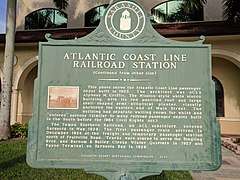 Historical marker commemorating the location of the Atlantic Coast Line Railroad's former Sarasota depot
Historical marker commemorating the location of the Atlantic Coast Line Railroad's former Sarasota depot- Venice Seaboard Air Line Railroad depot at the former southern terminus
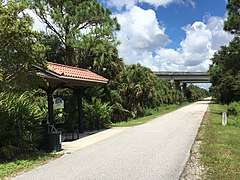 Legacy Trail on former right of way at milepost 898 near Laurel. The trail's mile markers match the railroad's mileposts.
Legacy Trail on former right of way at milepost 898 near Laurel. The trail's mile markers match the railroad's mileposts.
References
- Gruss, Jean. "Growth Engine". Business Observer. Retrieved 28 November 2016.
- "Lee County Rail Corridor Feasibility Study" (PDF). Lee County Metropolitan Planning Organization. Retrieved 2 July 2014.
- Turner, Gregg M. (December 1, 1999). Railroads of Southwest Florida. Images of America. Arcadia Publishing.
- "About Us". Seminole Gulf Railway. Retrieved 23 January 2014.
- "The Seminole Gulf Railway Excursion Trains". American Rails. Retrieved 28 November 2016.
- "Florida Christmas Light Extravaganza Train Ride". The Railroad Nation. Retrieved 28 November 2016.
- "Seminole Gulf Railway". Florida Weekly. Retrieved 2 July 2014.
- "Seminole Gulf Railway, L.P.–Acquisition and Operation Exemption–CSX Transportation, Inc" (PDF). Surface Transportation Board. Retrieved 10 April 2019.
- CSX Jacksonville Division Timetable
- Howard, Alex (22 November 2019). "City of Bonita Springs strikes deal to keep old rail bridge clean of graffiti". WBBH-TV. Retrieved 8 April 2020.
- Hensley, Donald. "Florida Southern's Narrow Gauge Years 1879-1896". Tap Lines. Retrieved 6 August 2017.
- "The Long Dock Enabled Transit to Havana, New Orleans and Key West". The Punta Gorda History Center Blog. Retrieved 7 July 2018.
- "Current Exhibits". Henry B. Plant Museum. Retrieved 16 July 2020.
- Turner, Gregg (2003). A Short History of Florida Railroads. Arcadia Publishing. ISBN 978-0-7385-2421-4.
- Cottrill, Cathy. "Remember: Local historian shares details about railroad depot once located in Bonita". Naples Daily News. Retrieved 24 January 2017.
- "Seminole Gulf Railway, L.P.--Adverse Abandonment--in Lee County, FL". Surface Transportation Board. Retrieved 27 August 2014.
- Surface Transportation Board (PDF) https://www.stb.gov/filings/all.nsf/ba7f93537688b8e5852573210004b318/e19a66cb9866247985258439005e2c88/$FILE/248200.pdf. Retrieved 22 August 2019. Missing or empty
|title=(help) - Alexander, Cassidy (20 December 2017). "Land acquired for first portion of Legacy Trail extension". Your Observer. Retrieved 18 March 2018.
- "Seminole Gulf Railway, L.P. - Abandonment Exemption- in Sarasota County, Fla". Surface Transportation Board. Retrieved 18 March 2018.
- Handelman, Jay. "Ringling Bros. returning to Southwest Florida". Sarasota Herald Tribune. Retrieved 30 July 2017.